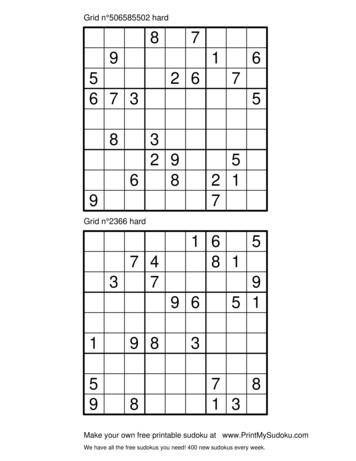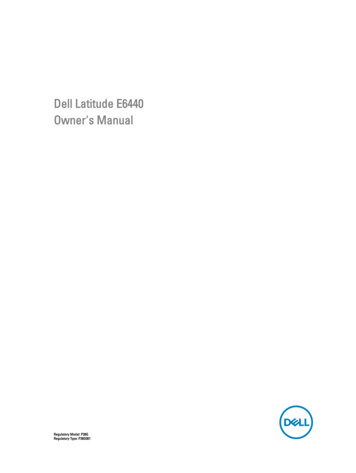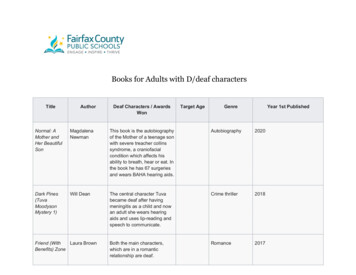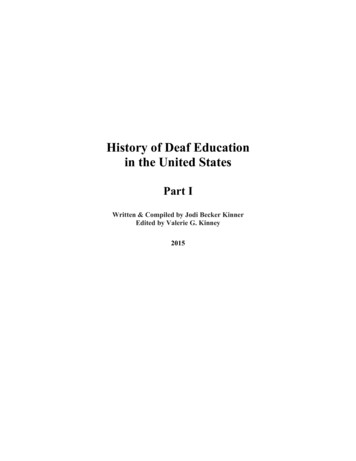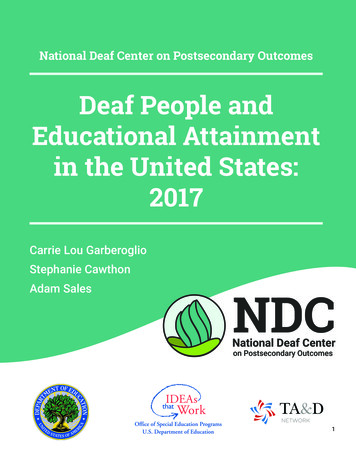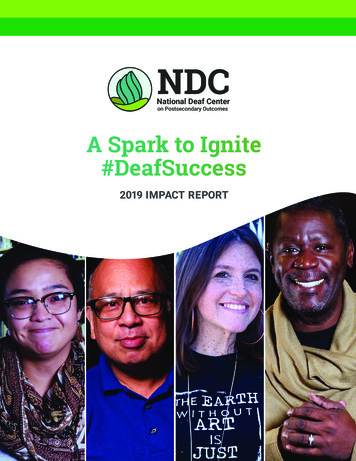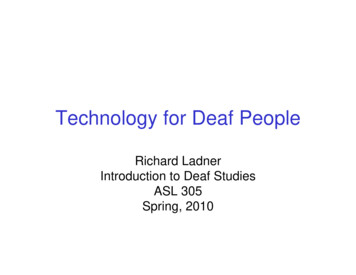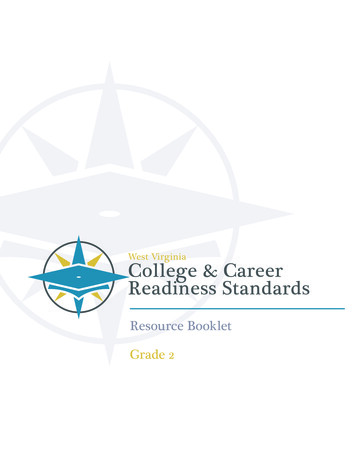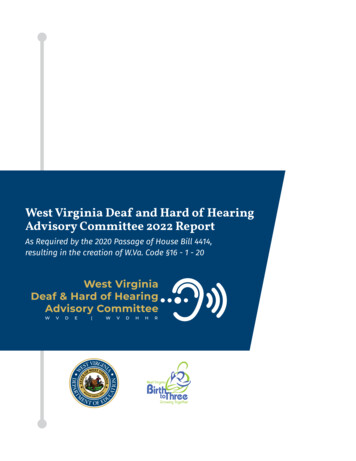
Transcription
West Virginia Deaf and Hard of HearingAdvisory Committee 2022 ReportAs Required by the 2020 Passage of House Bill 4414,resulting in the creation of W.Va. Code §16 - 1 - 20
Part One: ResponsibilitiesW.Va. Code §16 - 1 – 20 requires the West Virginia Department of Health and Human Resources(WVDHHR) and the West Virginia Department of Education (WVDE), consistent with federal lawregarding the education of children with disabilities and federal law regarding the privacy of studentinformation, to do the following:Responsibility #1: Establish an advisory committee to solicit input from certain stakeholders onthe selection of language developmental milestones for children who are deaf or hard of-hearingthat are equivalent to those for children who are not deaf or hard-of-hearing for inclusion in thefamily resource.2022 Progress: The West Virginia Deaf and Hard of Hearing Advisory Committee (WVDHHAC) hasbeen established based on the parameters set forth in House Bill 4414 and W.Va. Code §16 - 1 – 20.Membership is listed in the chart below:2022 Membership of the West Virginia Deaf and Hard of Hearing Advisory CommitteeNameRole as required by HB 4414TitleAgencyContactDr. MonicaDellaMeaWVDE nBrammerWVDE RepresentativeCoordinatorWVDElbrammer@k12.wv.usPam RoushDHHR RepresentativeDirectorWV Birth to ThreePam.S.Roush@wv.govDelegate RuthRowanEx Officio MemberDelegateWV Legislatureruth.rowan@wvhouse.govPat HombergEx Officio MemberSpecial EducationCoordinatorWVSDBphomberg@k12.wv.usMelanie Hesse» Early Interventionist of deaf and hard ofhearing children who is knowledgeable inthe use of the dual languages of Englishand American Sign Language (ASL)» Credentialed Educator of deaf and hardof hearing children whose expertise is incurriculum and instruction in AmericanSign Language (ASL) and English.WVSDB Dean ofStudentsWVSDB Outreachmhesse@k12.wv.usAllisonCunninghamParent of a child who is deaf or hard ofhearing who uses assistive technology tocommunicate with spoken EnglishPresidentWV AG BellLex12jen7@yahoo.comDr. NancyGillespieEducational Audiologist who can addressthe issues of aural habilitation and assistivetechnology to advocate for childrenusing spoken language in in StateEducationalCooperativeNgillispie@gmail.comDr. Jodi Cottrell» Educational Audiologist who canaddress the issues of aural habilitationand assistive technology to advocatefor children using spoken language inmainstream environments» Advocate for teaching the use ofinstruction in assistive technology tocommunicate with spoken English.Director of theMU L-Lab andAudiologistMarshall University cottrellj@marshall.eduLuke Lee Listening,Language, andLearning Lab (L-Lab)1
2022 Membership of the West Virginia Deaf and Hard of Hearing Advisory Committee2NameRole as required by HB 4414TitleAgencyContactJenn BakerCredentialed Provider: Speech LanguagePathologist of deaf and hard of hearingchildren who is knowledgeable in the use ofassistive technology to communicate withspoken English.Speech LanguagePathologist (SLP)Marshall UniversityL-Labjen.baker@marshall.eduChristina PayneParent of a Child who is hard of hearing thatuses the dual languages of American SignLanguage and EnglishDirector of WVHands and VoicesWV Hands & VoicesChristina.payne@wvhandsandvoices.orgKaren Haines» Expert who researches or is knowledgeable Retired SLPin the research regarding languageoutcomes for deaf and hard of hearingchildren using assistive technology tocommunicate with spoken English.» Credentialed Provider: Speech LanguagePathologist of deaf and hard of hearingchildren who is knowledgeable in the useof assistive technology to communicatewith spoken English.WVUKaren.Haines@mail.wvu.eduNora SmithStevenson» Early Interventionist of deaf and hard ofhearing children who is knowledgeable inthe use of the dual languages of Englishand American Sign Language (ASL)» Credentialed Educator of deaf and hardof hearing children whose expertise is incurriculum and instruction in AmericanSign Language (ASL) and English.WVSDB Outreachnsmith@k12.wv.usAnnette Carey» Expert who researches or is knowledgeable WVBTT Sensoryin the research regarding languageConsultantoutcomes for deaf and hard of hearingchildren using American Sign Language(ASL) or English» Credentialed Educator of deaf and hardof hearing children whose expertise is incurriculum and instruction in AmericanSign Language (ASL) and English.WV Birth toThree ContractedSpecialistannettecarey56@gmail.comScott Hottle» Parent of a Child who is hard of hearingthat uses the dual languages of AmericanSign Language and English» Credentialed Educator of deaf and hardof hearing children whose expertise is incurriculum and instruction in AmericanSign Language (ASL) and English.Director WV DeafServices CenterWV Deaf ServicesCenterhottle2000@yahoo.comPatricia Shaffer- Early Interventionist of deaf and hard ofDresslerhearing children who is knowledgeablein the use of assistive technology tocommunicate with spoken EnglishDHH en HottTeacher of theDeaf of Hard ofHearingBy Contract:Hampshire County/Tucker Countyklhott@k12.wv.usCredentialed Educator of deaf and hardof hearing children whose expertise is incurriculum and instruction in American SignLanguage (ASL) and English.WVSDB OutreachDHH Specialist
2022 Membership of the West Virginia Deaf and Hard of Hearing Advisory CommitteeNameRole as required by HB 4414TitleAgencyContactMolly SimontonCredentialed Educator of deaf and hardof hearing children whose expertise is incurriculum and instruction in American SignLanguage (ASL) and English.Contract DHHTeacher, AdjunctProfessor for MUDHH CertificationProgramKanawha County and Molly.simonton@Marshall University marshall.eduKrystal SheltonDoshAdvocate for teaching the use of duallanguages of American Sign Language (ASL)and English.WVSDB TeacherWVSDB AlumniAssociationkshelton@k12.wv.usAshley SuddathCredentialed Provider: Speech LanguagePathologist of deaf and hard of hearingchildren who is knowledgeable in the use ofdual languages of American Sign Language(ASL) and ity #2: Jointly select language developmental milestones from existing standardizednorms, to develop a family resource for use by families and service providers to understand andmonitor deaf and hard-of-hearing children’s receptive and expressive language acquisition andprogress toward English literacy development.2022 Progress: Members of the WVDHHAC will soon begin reviewing the most recent research bythe Center for Disease Control (CDC) to include updated language to “The West Virginia ResourceGuide for Families of Young Children,” which is applicable for children ages birth to five. Thisdocument contains developmental language milestones that have been synthesized using avariety of national and state-level research-based resources.Responsibility #3: Prepare a list of valid and reliable existing tools for assessments for serviceproviders that can be used periodically to determine the receptive and expressive language andliteracy development of deaf and hard-of-hearing children.2022 Progress: Members of the WVDHHAC have been given a copy “Assessment Options forChildren with Hearing Loss: A Collaborative list of assessment options for Deaf and Hard ofHearing Children (Birth to Age 5).” This document will be reviewed periodically.Responsibility #4: Disseminate the family resource and the educator tools and assessments,as well as the provision of informational materials on the use of the resources, tools, andassessments; imposing certain requirements on the child’s individualized family service plan teamand individual education program team if a deaf or hard-of-hearing child does not demonstrateprogress in receptive and expressive language skills.2022 Progress: Once updated, the revised guide will be distributed to West Virginia Birth toThree Providers and WVDE Technical Assistance Center for Accessibility and Transitions OutreachProviders who serve children with hearing loss to families they serve as well.The “Assessment Options for Children with Hearing Loss: A Collaborative list of assessmentoptions for Deaf and Hard of Hearing Children (Birth to Age 5)” has been distributed to CountyCollaborative Early Childhood Team members to assist with transitioning children into WestVirginia Universal Pre-K Programs and will be further disseminated in the coming months.3
Responsibility #5: Annually produce an aggregated report that is specific to language and literacydevelopment of children whose primary exceptionality is deaf and hard-of-hearing from birth tofive years of age.2022 Progress: Please see below for the aggregated reports of children served whose primaryexceptionalities are deaf and hard-of-hearing:Please note that the following data are based on federal reporting requirements as identified inthe Individuals with Disabilities Education Act, parts C and B, respectively.West Virginia Birth to Three Primary Eligibility* **Birth Through Age 2Hearing Loss58Hearing/Vision Loss17Total:75*Data Source: December 1, 2021 Child Count**Federal law does not require a secondary exceptionality be identified for reporting purposes.West Virginia Ages 3 through 5 Enrollment by Age and Grade for Students with Hearing Impairments ***Primary ExceptionalityAges 3-5*PK Students Aged 3-5**Hard of Hearing (HI)4524Deaf (DF)97Deaf Blind (DB)43Total:5834*Count by age includes PK and K students up to age 5**Count by grade level includes only PK students***Federal law does not require a secondary exceptionality be identified for reporting purposes.Data source: December 1, 2021 Child Count4
Part Two: Next Steps for 2022-20231.Continue to honor the family, specifically the parents, as the child’s first teacher, including thefamily’s right to choose the mode of communication (signing versus spoken language) that theirdeaf or hard of hearing child will utilize.2. Continue to focus on family partnerships to help ensure all children, particularly those whoare deaf or hard of hearing, have ample opportunities to develop language milestones prior toschool entry.3. Continue to ensure the following interrelated variables are considered as part of the educationalevaluation process for all children who are deaf or hard of hearing:» Audiological Factors Age of onset and age of identification Age of full-time amplification Auditory skills and use of residual hearing. Effectiveness of hearing technology Etiology of the hearing loss Type and degree of hearing loss» Behavioral Factors Attitude and motivation level of the student Psychosocial behaviors» Communication Factors Augmentative communication devices; assistive technology Language abilities or disabilities Primary language Preferred mode of communication» Educational Factors Additional eligibilities or exceptionalities Attendance consistency and stability Early education Performance on curriculum-based assessments and measures» Social-Developmental-Medical Factors Family history (i.e., home language, cultural factors, etc.) Genetic history Medical issues/concerns: risk factors (i.e., birth trauma, infections, syndromes, andmedical alerts), mental health, routine medications, etc. Parent knowledge and support Vision status4. Partner with the Newborn Hearing Screening Committee, the Early Childhood Advisory Council ofWest Virginia, and pediatricians statewide to make available “The West Virginia Resource Guidefor Families of Young Children,” which includes the language developmental milestones forchildren ages birth to five who are deaf or hard of hearing.5
5. Continue to adhere to all federal and subsequent state laws regarding services for childrenwith disabilities using a focus on the whole child. West Virginia DHHR adheres to IDEA, Part Cfor children ages birth to three, while the WVDE adheres to IDEA, Part B for children ages threethrough 21. The components of IDEA Part B are reflected in WVBE Policy 2419 (Regulations for theEducation of Students with Exceptionalities). This State Board of Education Policy requires thefollowing.a. For a child who is deaf or hard of hearing, a comprehensive language assessment in thechild’s language and communication mode must be included in his/her evaluation.b. Pg. 51, Section 2.E: If the student who is deaf or hard of hearing does not demonstrateprogress in expressive or receptive language skills as measured through an appropriateassessment tool, the IEP Team must explain the reasons for the lack of progress in meetingthe language milestones or progressing toward them and recommend specific strategies,services, and programs that will track the child’s success toward English literacy.6. Disseminate documents for families of Deaf and Hard of Hearing via the various stakeholderswho are members of West Virginia Deaf and Hard of Hearing Advisory Committee.7. Continue to expand upon existing partnerships between WV DHHR, the WVDE, and the WVDE’sOutreach Program for Accessibility and Transitions at the West Virginia Schools for the Deaf andthe Blind to provide additional services for a larger population of children ages birth to fivewhose primary exceptionality is identified as deaf or hard of hearing.8. Continue to provide WVDE-sponsored professional learning that is co-led by state-level speechlanguage pathology experts to provide professional learning that focuses on comprehensivelanguage evaluation and reporting guidance for those speech-language pathologists, teachers ofthe deaf/hard of hearing, and district special education directors who work with children agesbirth to age five.For additional information, contact a co-chair of the West Virginia Deaf and Hard of HearingAdvisory Committee:»»6Dr. Monica DellaMea, mdellamea@k12.wv.us orMs. Pam Roush, pam.s.roush@wv.gov
W. Clayton BurchWest Virginia Superintendent of Schools
Update on the West VirginiaSchools for the Deaf and the BlindWEST VIRGINIA SCHOOLS FOR THE DEAF AND THE BLIND (WVSDB) Fulfilling the mission of the school as outlined in W. Va. Code §18-17-1, et seq., to be thecenter of excellence in the education of deaf, hard of hearing, blind, low vision, and deafblindstudents across the state ofWest Virginia. Fostering a culture of success and increasing post-secondary opportunities for graduates. Focusing on student well-being, appropriate social-emotional supports, and opportunities forresidential students. Providing an immersive educational experience for students with low incidence disabilities. Ensuring student access to educational materials. Increasing the efficiency of the operations of the WVSDB to directly meet the needs ofstudents:» Finances» Facilities and Campus Safety» Personnel Collaborating with community partners to increase availability of services and support forstudents.WEST VIRGINIA DEPARTMENT OF EDUCATION TECHNICAL ASSISTANCE CENTERFOR ACCESSIBILITY AND TRANSITIONS (WVDE TACAT) MISSION: To educate, train, guide, and support district administrators, educators, relatedservice providers, and families to build understanding, implement practices, and transitionfrom birth to post-secondary for students with access exceptionalities. VISION: To improve educational equity for students with access exceptionalities by providingeducational materials, assistive technology, transition, and supports statewide through trainingand technical assistance to district staff. COLLABORATING AGENCIES: WVDE TACAT, Instructional Resource Center (IRC), Division ofRehabilitation Services (DRS), WV Birth to Three (WVBTT), West Virginia Adult Education,SPOKES, and EPIC, the West Virginia Department of Education (WVDE), and the WVSDB.Additional onsite partners will be moving into our WVDE TACAT extension site in theBrannon Building.
West Virginia Board of Education2022-2023L. Paul Hardesty, PresidentNancy J. White, Vice PresidentF. Scott Rotruck, Financial OfficerRobert W. Dunlevy, MemberMiller L. Hall, MemberDaniel D. Snavely, M.D., MemberDebra K. Sullivan, MemberJames S. Wilson, D.D.S., MemberSarah Armstrong Tucker, Ph.D., Ex OfficioChancellorWest Virginia Higher Education Policy CommissionWest Virginia Council for Community and Technical College EducationW. Clayton Burch, Ex OfficioState Superintendent of SchoolsWest Virginia Department of Education
West Virginia School DisciplineReport as Required byWest Virginia Code §18-2-43July 2022
West Virginia Board of Education2022-2023L. Paul Hardesty, PresidentNancy J. White, Vice PresidentF. Scott Rotruck, Financial OfficerRobert W. Dunlevy, MemberMiller L. Hall, MemberDaniel D. Snavely, M.D., MemberDebra K. Sullivan, MemberJames S. Wilson, D.D.S., MemberSarah Armstrong Tucker, Ph.D., Ex OfficioChancellorWest Virginia Higher Education Policy CommissionWest Virginia Council for Community and Technical College EducationW. Clayton Burch, Ex OfficioState Superintendent of SchoolsWest Virginia Department of Education
IntroductionThe following report provides an overview of the statewide disciplinary data from SY2017-2018 throughSY2021-2022. The following supports make up a comprehensive approach to student discipline, from astatewide perspective. While supports are provided at a state level, it is important to note that eachcounty has the ultimate autonomy to select programs, plans, or processes that best fit the needs ofindividual school communities. Each school also has the duty to record and implement disciplinepractices. A list of additional county-selected supports can be found here.Supports for Student Behavior and Student Discipline»Policy 4373: Expected Behavior in Safe and Supportive Schools»West Virginia Multi-Tiered System of SupportSocial Emotional/Behavior Supports»WV College and Career Readiness Dispositions and Standards for Student Success »WV Behavior & Mental Health Technical Assistance Center (BMHTAC) »Positive Behavior Interventions & Supports (PBIS)Mental Health/Trauma Supports»WV Expanded School Mental Health (ESMH)»WV Behavior and Mental Health Technical Assistance Center (BMHTAC)»Project AWARE (ESMH & PBIS)»Handle with Care»PREPaRE Model Crisis Intervention»Trauma-Informed Elementary Schools (DHHR)»24/7 Children’s Crisis and Referral Line»Prevent Suicide WV Training (DHHR)1
Support for At-Risk Students»Communities In Schools (CIS)»Homeless Grant / McKinney Vento»West Virginia Schools of Diversion & Transition»Neglected and Delinquent State Agency Program»Neglected and Delinquent Local Educational Agency Program»Guidepost to GraduationSubstance Abuse Prevention»WVBE Policy 2520.5 – WV College andCareer Readiness Dispositions and Standards for WellnessEducation»WVBE Policy 2520.19 – WV College and Career Readiness Dispositions and standards for StudentSuccess»WV Students Against Destructive Decisions (SADD)»WVDHHR Prevention Lead OrganizationsCommunity Partnerships/Initiative»21st CCLC Afterschool Programs»WV Family Engagement Grant»Parent Educator Resource Centers (PERC) /Family Engagement Resource Centers (FERC)»School Based Health Centers»Lawyers in Schools Programs»DHHR Office of Children, Youth & Families2
Data and Analysis on School DisciplineTable 1: Student Enrollment and SubgroupsTable 1 provides information by school year on student subgroups based on total student enrollment.The percentages describe the proportion of the total student population represented by eachsubgroup. For example, in school year 2019-2020, students identified as Low Socioeconomic Status(SES) represented approximately 47% of the total student population.Table 1: Student Enrollment and 1.8%1.9%2.0%2.0%2.1%Other Minority0.8%0.8%0.8%0.8%0.7%Students ts withDisabilities16.7%17.1%17.4%17.7%17.9%Not Low SES50.8%52.5%53.1%52.1%50.0%Low SES49.2%47.5%46.9%47.9%50.0%Not in Care97.9%97.8%97.8%98.5%Foster Care2.1%2.2%2.2%1.5%All StudentsGenderRace/EthnicitySpecial EducationSocioeconomicStatusFoster Care Status(EOY)3
Table 2: Population Distribution of Disciplinary Referrals Overall and by Incident Severity LevelTable 2 provides information by school year on discipline referrals, including breakdowns by incidentseverity level and student subgroup information. The percentages describe the proportion of allreferrals (either overall or by severity level) that involved students in the identified subgroup.For example, in school year 2018-2019 of all Level 2 Referrals, approximately 73% involved studentswithout disabilities.Table 2: Population Distribution of Disciplinary ReferralsIncident Severity LevelDisciplinary Referrals2017-2018All ReferralsAll ReferralsLevel 1Level 2Level 3Level .6%1.6%1.4%2.0%Other ities77.1%80.9%72.2%67.7%60.5%Students withDisabilities22.9%19.1%27.8%32.3%39.5%Not Low SES30.9%32.4%28.7%27.6%28.4%Low SES69.1%67.6%71.3%72.4%71.6%Not in Care94.6%95.1%94.1%93.1%91.5%Foster nSocioeconomicStatusFoster CareStatus2018-2019All ReferralsGender4
Table 2: Population Distribution of Disciplinary ReferralsIncident Severity LevelDisciplinary icStatusFoster CareStatus2019-2020All ReferralsLevel 1Level 2Level 3Level atino1.8%1.8%1.8%1.4%1.9%Other ities77.0%80.5%72.7%68.7%56.6%Students withDisabilities23.0%19.5%27.3%31.3%43.4%Not Low SES42.9%44.2%41.2%40.0%42.2%Low SES57.1%55.8%58.8%60.0%57.8%Not in Care95.0%95.4%94.5%93.6%91.6%Foster %5.7%Hispanic/Latino1.7%1.8%1.6%1.4%1.4%Other ities75.7%79.5%70.9%65.8%57.1%Students withDisabilities24.3%20.5%29.1%34.2%42.9%All ReferralsGenderRace/EthnicitySpecialEducation5
Table 2: Population Distribution of Disciplinary ReferralsIncident Severity LevelDisciplinary ReferralsSocioeconomicStatusFoster ationSocioeconomicStatusFoster CareStatus6All ReferralsLevel 1Level 2Level 3Level 4Not Low SES30.9%32.2%29.2%27.4%27.4%Low SES69.1%67.8%70.8%72.6%72.6%Not in Care94.8%95.2%94.3%93.7%92.0%Foster spanic/Latino1.3%1.4%1.1%1.4%1.1%Other ities72.8%75.5%70.1%67.9%56.8%Students withDisabilities27.2%24.5%29.9%32.1%43.2%Not Low SES31.6%33.1%30.4%27.5%29.0%Low SES68.4%66.9%69.6%72.5%71.0%Not in Care96.5%96.8%96.3%95.5%95.4%Foster Care3.5%3.2%3.7%4.5%4.6%All Referrals
Table 2: Population Distribution of Disciplinary ReferralsIncident Severity LevelDisciplinary Referrals2021-2022All ReferralsLevel 1All ReferralsLevel 2Level 3Level 1.9%1.9%1.6%1.5%Other ities75.2%78.0%71.6%68.7%63.8%Students withDisabilities24.8%22.0%28.4%31.3%36.2%Not Low SES34.5%35.4%33.6%31.5%32.3%Low SES65.5%64.6%66.4%68.5%67.7%Not in Care----------Foster SocioeconomicStatusFoster CareStatus7
Table 3: Intervention Categories Overall and by Incident Severity Level(for referrals where action was warranted)Table 3 provides information by school year about the intervention/actions taken for referralswhere actions were warranted, including incident severity level and intervention/action category.The percentages describe the proportion of all interventions/actions accounted for by the specifiedcategory. For example, in school year 2017-2018, approximately 13% of all interventions for Level 4behavior referrals resulted in “Other Interventions” that did not remove students from learning orsocial opportunities (e.g., referrals for counseling or other services).Table 3: Intervention Categories Overall and by Incident Severity LevelIntervention Categoriesfor Referrals2017-2018Total Actions/InterventionsAll Actions/InterventionsLevel 1Level 2Level 3Level 9.50%0.60%In-School f-School 6%24.84%10.56%0.62%In-School f-School 7%23.78%9.28%0.84%In-School f-School 38%17.42%Alternative Education PlacementExpulsionOther Interventions2018-2019Alternative Education PlacementExpulsionOther Interventions2019-2020Alternative Education PlacementExpulsionOther Interventions8
Table 3: Intervention Categories Overall and by Incident Severity LevelIntervention Categoriesfor Referrals2020-2021Total Actions/InterventionsAll Actions/InterventionsLevel 1Level 2Level 3Level .70%In-School -School 20.31%7.76%0.44%In-School f-School 95%10.11%Alternative Education PlacementExpulsionOther Interventions2021-2022Alternative Education PlacementExpulsionOther Interventions9
10Foster Care StatusSocioeconomicStatusSpecial %23.0%30.9%69.1%94.6%5.4%Other MinorityStudents withoutDisabilitiesStudents withDisabilitiesNot Low SESLow SESNot in CareFoster eMulti-racial25.3%201,772FemaleAll InterventionsAll Actions/Intervention Categories within Population 8%74.4%25.6%72,045DetentionTable 4: Population Distribution of Discipline Intervention 10.6%83.2%74.1%25.9%60,334OtherInterventionsTable 4 provides information by school year on discipline intervention/action categories for each student subgroup. The percentagesdescribe the proportion of the interventions/actions in each category that involved students in the specified subgroup. For example, inschool year 2018-2019, female students were involved in approximately 27% of all expulsions for the year.Table 4: Population Distribution of Disciplinary Intervention Categories
11Foster Care StatusSocioeconomicStatusSpecial %23.1%42.9%57.1%95.0%5.0%Other MinorityStudents withoutDisabilitiesStudents withDisabilitiesNot Low SESLow SESNot in CareFoster eMulti-racial26.4%207,338FemaleAll Actions/InterventionsAll Actions/Intervention Categories within Population %73.1%26.9%75,020DetentionTable 4: Population Distribution of Discipline Intervention 0.9%82.6%72.6%27.4%60,609OtherInterventions
12Foster Care StatusSocioeconomicStatusSpecial EducationRace/EthnicityGender2019-202094.8%Not in Care5.2%69.2%Low SESFoster Care30.8%Not Low SES75.6%Students withoutDisabilities24.4%0.3%Other MinorityStudents l Actions/InterventionsAll Actions/Intervention Categories within Population 3.0%4.1%92.7%77.0%23.0%AlternativeEducation
Part One: Responsibilities W.Va. Code §16 - 1 - 20 requires the West Virginia Department of Health and Human Resources . WVDE Representative Director WVDE mdellamea@k12.wv.us LeeAnn Brammer . Director of the MU L-Lab and Audiologist Marshall University Luke Lee Listening, Language, and Learning Lab (L-Lab) cottrellj@marshall.edu. 2


